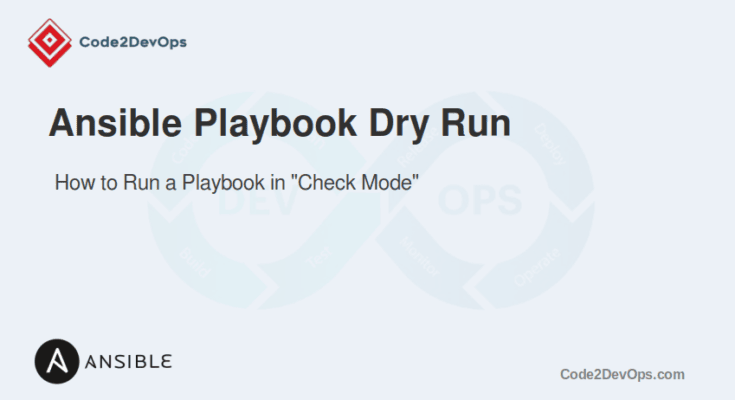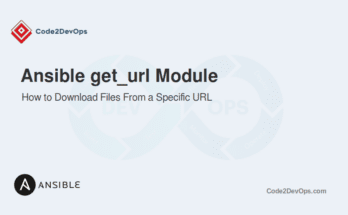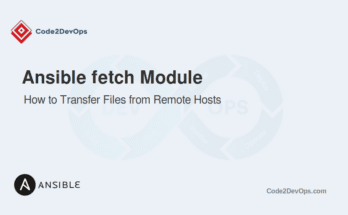Check mode (–check) is a feature in Ansible that allows you to run playbooks without making any changes to the target systems. This mode is also known as a “dry run” and is useful for testing and verifying playbooks.
This guide will explore the concept of a dry run in Ansible, its importance, and how to use it effectively with practical examples.
Table of Contents
What is Ansible Dry Run?
In Ansible, a dry run is called a “check mode“. When you run a playbook in check mode, Ansible executes the tasks but does not make any actual changes. It will report what changes would have been made if the playbook was run in normal mode. This helps you identify potential issues and ensure the playbook works as intended.
Dry runs are useful for several reasons:
- Safety: Ensure that your playbook does not inadvertently disrupt services or configurations.
- Validation: Verify that your tasks will execute as expected.
- Debugging: Identify issues in your playbook logic or syntax without affecting the target systems.
- Compliance: Ensure changes meet organizational policies and standards before implementation.
How to Perform a Dry Run
To perform a dry run in Ansible, you can use the –check flag when running your playbook. This flag tells Ansible to go through the series of tasks without actually applying any changes. Additionally, you can use the –diff flag to see the differences between the current and desired states as defined in your playbook.
Let’s perform a dry run with the ansible-playbook command.
# ansible-playbook playbook.yml --checkIncluding Check Mode in Playbook
You can also specify check mode within your playbook by using the check_mode directive at the task level.
Here is an example playbook for the dry run.
- name: Update web server configuration
hosts: webservers
become: yes
tasks:
- name: Ensure Apache is installed
apt:
name: apache2
state: present
check_mode: yesThis playbook uses the apt module to ensure Apache is installed on webservers hosts in check mode with elevated privileges.
Using the Diff Option
The –diff option shows you the differences that would be made to the files on the target systems.
# ansible-playbook playbook.yml --diffYou can also combine the –diff and –check to get a comprehensive view of what changes would be made and how the files would be modified.
# ansible-playbook playbook.yml --check --diffAnsible Dry Run: Practical Examples
Let’s explore some practical scenarios where performing a dry run can be beneficial.
Example 1: Verifying Configuration Changes
Suppose you have a playbook that updates the configuration of a web server. Before applying these changes in a live environment, ensure they will not cause any issues.
Let’s create a playbook named webserver_config.yml.
---
- name: Update web server configuration
hosts: webservers
become: yes
tasks:
- name: Ensure Apache is installed
apt:
name: apache2
state: present
- name: Update the Apache configuration file
template:
src: /templates/apache2.conf.j2
dest: /etc/apache2/apache2.conf
notify: Restart Apache
handlers:
- name: Restart Apache
service:
name: apache2
state: restartedNow, run the above playbook with check mode.
# ansible-playbook webserver_config.yml --check --diffThe above command will simulate the configuration changes, allowing you to verify that the template file will be correctly applied.
Example 2: Testing Playbook Syntax and Logic
Dry runs are also helpful for testing the syntax and logic of your playbooks. For example, if you have a playbook that deploys a multi-tier application, you can use check mode to ensure all tasks are correctly defined.
Create a playbook named deploy_application.yml.
---
- name: Deploy multi-tier application
hosts: app_servers
become: yes
tasks:
- name: Install necessary packages
apt:
name: "{{ item }}"
state: present
loop:
- nginx
- postgresql
- python3-venv
- name: Deploy application code
git:
repo: 'https://github.com/example/app.git'
dest: /var/www/app
- name: Start application services
service:
name: "{{ item }}"
state: started
loop:
- nginx
- postgresqlNow, perform a dry run.
# ansible-playbook deploy_application.yml --check --diffThis will help you ensure that all tasks are syntactically correct and logically sound before changing your servers.
Real-World Use Case: Upgrading a Web Application
Consider a scenario where you need to upgrade a web application across multiple servers. This upgrade involves updating the application code, database schema, and configuration files. A dry run can help ensure that the upgrade process will proceed smoothly without causing downtime or data loss.
Create a playbook named upgrade_webapp.yml.
---
- name: Upgrade web application
hosts: web_servers
become: yes
vars:
app_version: "2.0"
tasks:
- name: Pull latest application code
git:
repo: 'https://github.com/example/webapp.git'
dest: /var/www/webapp
version: "{{ app_version }}"
check_mode: yes
- name: Apply database migrations
command: /var/www/webapp/manage.py migrate
args:
creates: /var/www/webapp/db/migrations/applied
check_mode: yes
- name: Update application configuration
template:
src: /templates/webapp.conf.j2
dest: /etc/webapp/webapp.conf
notify: Restart webapp
check_mode: yes
handlers:
- name: Restart webapp
service:
name: webapp
state: restarted
check_mode: yesNow, perform a dry run.
# ansible-playbook upgrade_webapp.yml --check --diffIn the above playbook:
- Pull latest application code: This task clones the latest code from the repository without applying changes to the file system.
- Apply database migrations: This task simulates the application of database migrations, ensuring that no errors occur.
- Update application configuration: This task verifies that the configuration file will be correctly templated and deployed.
- Handlers: Even handlers can be run in check mode to ensure they will trigger correctly without restarting the service.
Running this dry run will allow you to identify potential issues in the upgrade process, such as missing dependencies, syntax errors, or incorrect configurations, without making any changes to the production environment.
Conclusion
Performing a dry run in Ansible is a powerful way to ensure your playbooks are correct and safe before applying system changes. By using the –check and –diff flags, you can validate configurations, test syntax and logic, and simulate complex deployment scenarios with confidence.
FAQs
1. Is there a way to skip Check Mode for specific tasks?
Yes, you can use check_mode: no within a task to make sure it runs even in Check Mode.
2. Does Check Mode detect syntax errors in the playbook?
Yes, Check Mode helps in detecting syntax errors, variable issues, and logical errors in tasks.
3. Can I perform a dry run with a specific tag in a playbook?
Yes, you can use --tags to specify which tagged tasks to test in Check Mode.




